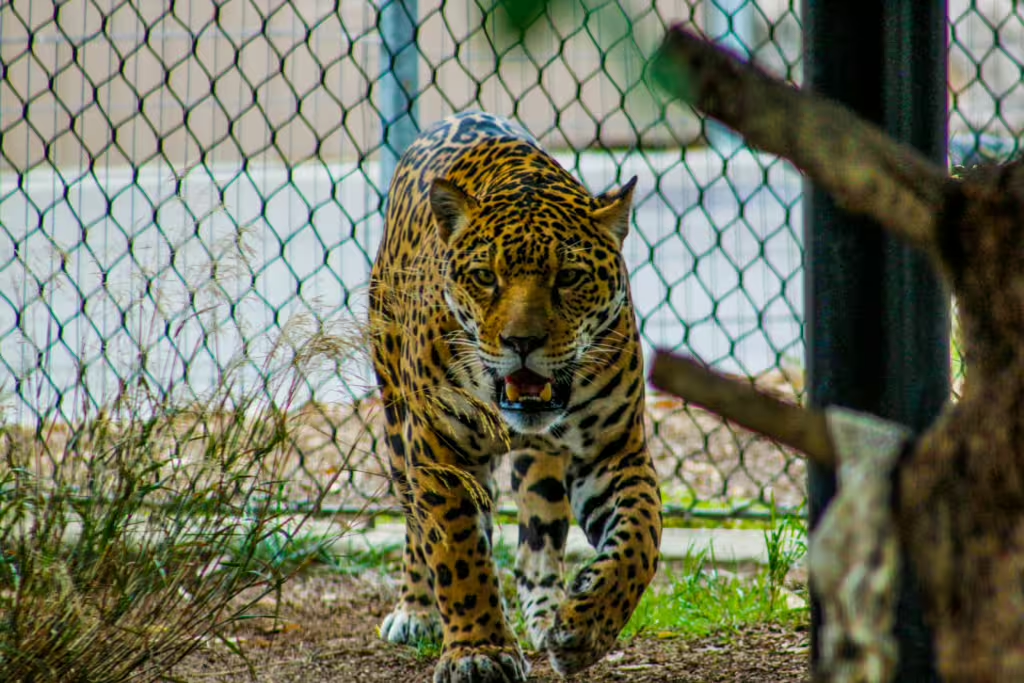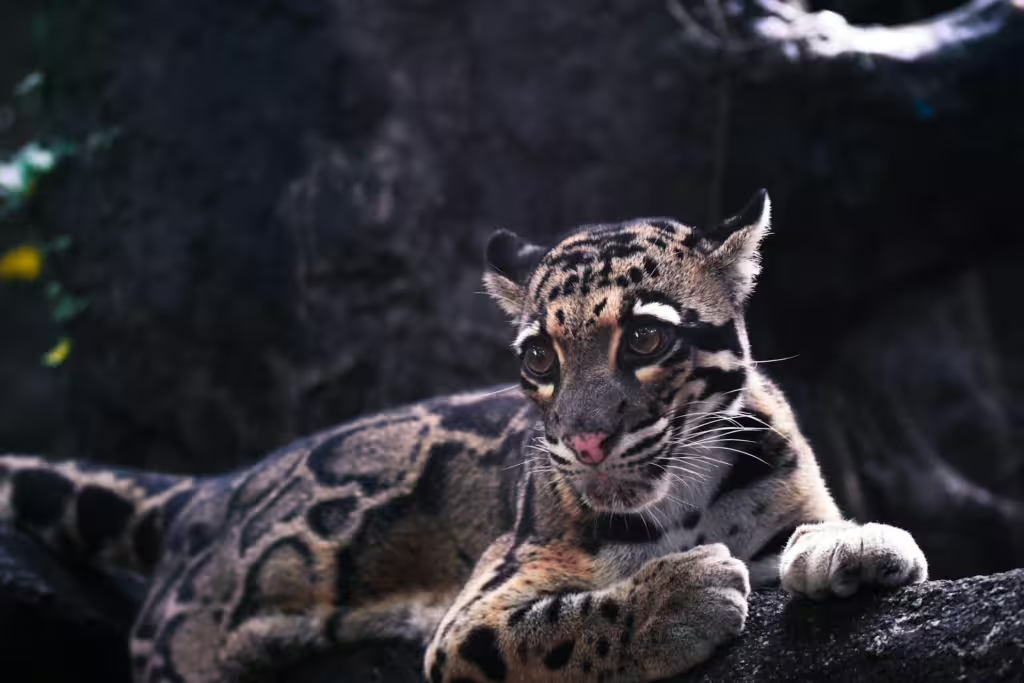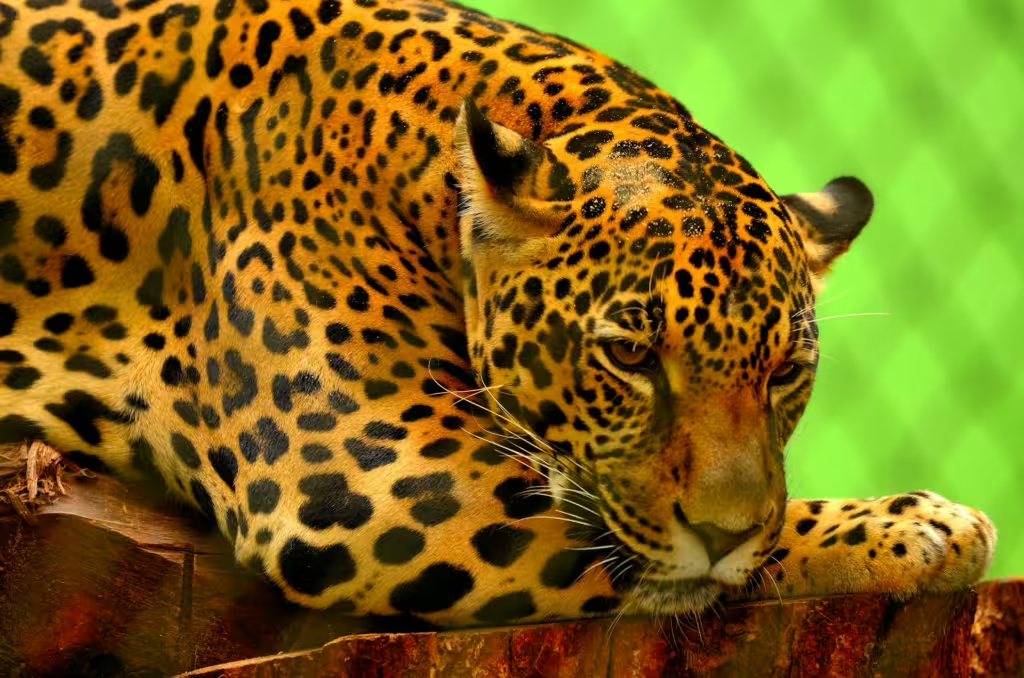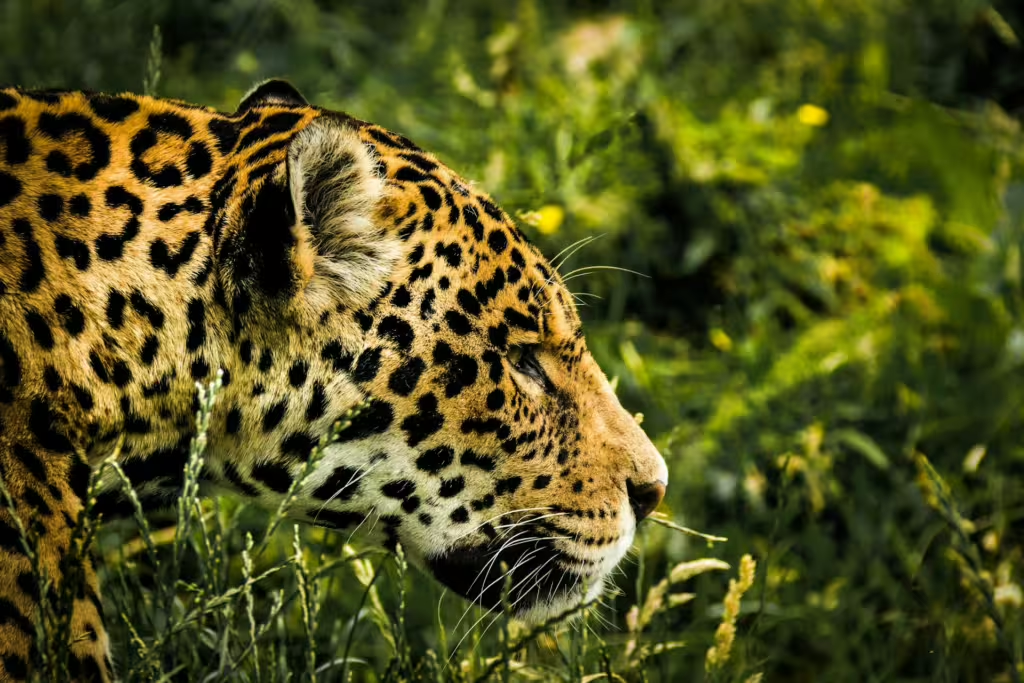Imagine if you will, that you are walking along through a South American jungle. The rainforest that surrounds you is lush, green, and inviting. It is teeming with life, echoing with the calls of mellifluous birds, buzzing insects, and hooting primates. Amidst the din and the natural beauty, you fail to notice one, important thing; something is hunting you. Crouching below the undergrowth or stalking form just below the canopy, the jaguar stalks its unwary prey, and if you’re not careful, you could easily fall victim to its deadly teeth and claws.
The jaguar, known by the scientific moniker, Panthera onca, is a powerful and enigmatic creature. This big cat is a master of stealth and strength, and one of the top predators of the Americas. As with most jungle cats, the iconic jaguar is a species revered for its agility, cunning, and adaptability. Jaguars, like their relatives—the leopard, panther, and other jungle cats—are keystone species, which means they are critical to the balance of their respective ecosystems.
In this article, we will endeavor to go behind the spots of the jaguar’s story. We will explore the daily life of the jaguar, examine its similarities and differences with other big cats, specifically those that live in similar biomes, and delve into the critical role these cats all play in their respective habitats. Just remember as you read, to keep eyes in the back of your head; you never know what you’ll find stalking in the bushes nearby!
The Jaguar: King of the Rainforest
Physical Characteristics
When it comes to big cats, the jaguar has a place near the top of the list; at least in terms of size. Jaguars are the third-largest cats in the world, following the tiger and lion. They also happen to be the largest in the Americas, with the cougar or puma trailing close behind them. Jaguars have a few easily recognizable characteristics. The first thing one sees, if one sees the jaguar at all with its excellent camouflage, is the big cat’s striking coat, which features rosettes—circular spots with a central dot. The second is the jaguar’s robust, stocky build and short, powerful legs.
Adult male jaguars are fairly massive and can weigh between 100 to 250 pounds. Jaguars, like many animals, exhibit sexual dimorphism, wherein the males and females are different sizes. In the case of the jaguar, the females are slightly smaller than the males. Male or female, however, the jaguar’s powerful jaws are unmatched among big cats. These strong mandibles have enormous bit pressure, capable of crushing the skulls or shells of prey; it is a trait that sets them apart from other predators.
Habitat and Range
Contrary to popular belief, jaguars aren’t just found in the Amazon rainforest. These resourceful felines can be found across a wide range of habitats, from the dense rainforests of the Amazon itself to dry scrublands in Central and South America; this will become even more important for jaguars as the years progress, as more and more of the felled Amazon is rapidly transforming the region into a more arid, desert-like climate. Historically, their range extended as far north as the southwestern United States.
It is the jaguar’s remarkable adaptability which allows them to thrive in various environments, but they still require abundant prey and access to water. An interesting thing about jaguars is that they are excellent swimmers and often hunt aquatic prey; This behavior distinguishes them from many other big cats. Nevertheless, most juguar populations today are primarily concentrated in the Amazon Basin.
Behavior and Hunting Tactics
Unlike lions which live in prides of many cooperating members, jaguars are solitary and territorial creatures. These quite kitties use stealth to ambush prey, relying on their camouflage to get within striking distance before they make their move. Unlike other big cats that target the throat, jaguars tend to use their powerful bite to pierce the skull or spinal cord of their prey, delivering a quick and very lethal blow.
A jaguar’s diet is diverse and includes over 85 species such as capybaras, peccaries, caimans, monkeys, snakes, and even turtles. This type of diet and opportunistic hunting behavior highlights the jaguar’s role as apex predators in their habitats. Apex predators are essential as their existence helps maintain a balanced ecosystem.
The Leopard: A Global Cousin
Physical Similarities and Differences
Leopards (Panthera pardus), are often confused with jaguars due to their spotted coats, but the two animals could not be more different. For one thing, leopards are only native to Africa and parts of Asia, not South or Central America. Leopards are not as stocky or large as their jaguar cousins. Instead, they are smaller, more slender, and the distinctive rosettes on their coats lack the central dots seen in jaguars.
Despite their size difference, however, leopards are equally agile and stealthy. Like jaguars, leopards hunt by ambushing prey by coming at them unawares. This adaptability and hunting expertise allows them to thrive in savannas, forests, and even mountainous regions.
Leopards’ Hunting Techniques
Leopards are expert climbers, some might say even better than jaguars, and they use it to great effect, often hauling their kills into trees to keep them safe from scavengers like hyenas and lions. Also, while jaguars prefer dense forests and water-based prey, leopards are generalists, preying on antelope, birds, and small mammals. Additionally, the leopard’s ability to adapt to various habitats and diets has earned them the widest range of any big cat. Sadly, as with almost every big cat on the planet, habitat loss and human-wildlife conflict have placed many leopard populations at risk.
The Panther: A Shaded Mystery
What Is a Panther?

People often use the term “panther” interchangeably in order to describe melanistic (black-coated) jaguars or leopards. This coloration is fairly common and is actually caused by an excess of melanin. The result is a genetic mutation that provides leopards and jaguars with a striking black coat.
Melanistic jaguars tend to live in denser jungles and rainforests where their dark coats offer better camouflage in low light. Similarly, melanistic leopards, often called “black panthers,” are common in Asian forests, such as those in Malaysia.
Behavior and Adaptations
While their hunting strategies and behaviors align with their non-melanistic counterparts, black panthers create a very different mystique. Their mysterious allure is not only due to their coloration, but their rare and elusive nature. In terms of raw danger, their dark coats make them more challenging to spot, adding to the mystery and danger they evince. This often leads to their portrayal as shadowy predators in folklore; though, not always. Bagheera, one of the main characters in Rudyard Kipling’s famous children’s book, The Jungle Book, is an Asian black panther. He is a wise and measured hunter, not unlike the creatures that inspired his creation.
Other Jungle Cats: The Lesser-Known Predators
Jaguars and leopards aren’t the only spotted cats living in the jungle. In fact, many smaller cats also play vital roles in jungle ecosystems. These species, though less well-known, are equally fascinating and adapted to life in these amazing habitats.
The Ocelot
The ocelot (Leopardus pardalis) is a medium-sized cat found in the Americas. Known for its beautiful, intricately patterned coat, this smallish animal resembles a smaller version of the jaguar. Ocelots are nocturnal hunters and are quire formidable, preying on rodents, reptiles, and birds by using concise ambush tactics and their singular agility. The biggest threat to these animals lies in habitat destruction, which minimizes their available living space and their ability to find and catch prey.
The Clouded Leopard

If the ocelot is the little jaguar of the Americas, then the clouded leopard (Neofelis nebulosa), is the little leopard of Southeast Asia. This highly unique species is patterned with large, cloud-shaped markings on its coat. Known for its climbing prowess, the clouded leopard spends rather more time resting or hunting in trees than its other spotted cousins on this list. Clouded leopards are skilled arboreal hunters, preying on tree-dwelling animals such as monkeys and birds, but they are just as capable of capturing and killing ground-dwelling prey like deer or wild pigs.
The Margay
The margay (Leopardus wiedii) is a small, tree-dwelling cat found in Central and South America. Though it looks somewhat similar to the ocelot, the margay is a completely different creature. Regardless of how much it appears to be an ocelot, margays are far better adapted to an arboreal lifestyle; much like the clouded leopard. These cats are highly agile and can leap between trees with ease. They primarily hunt birds, small mammals, and reptiles.
The Puma (Cougar)
Sometimes referred to as mountain lions or cougars, the puma (Puma concolor) can be found across the Americas, from Canada all the way down south to the southern Andes mountains. Pumas are by no means strictly a jungle cat. These amazing animals inhabit a wide range of environments, including temperate and mountain forests, as well as rainforests. Like jaguars, pumas are solitary hunters, preying on deer, small mammals, and livestock when they can get it. Their adaptability and elusive nature make them one of the most successful predators in the Western Hemisphere, though their general proximity to human settlements often results in conflict between themselves and local people.
The Role of Big Cats in Ecosystems
All jungle cats, from the mighty jaguar to the elusive margay, have a pivotal role to play in their respective ecosystems. These cats act as keystone species, controlling herbivore populations, and preventing overgrazing and overpopulation. This role ensures that local vegetation remains intact and prey animals do not starve. Predators of all sorts are a means of promoting biodiversity in natural ecosystems. These animals maintain a balance among prey species. Take jaguars, for instance. These main characters of our article are essential for regulating the populations of capybaras and peccaries within their territories. Without them, the ranks of these giant rodents and pigs would swell to such numbers that the local plant and animal life might be eaten out of house and home.
Conservation Challenges and Efforts
Threats to Big Cats
Despite their ecological importance and the roles they fill in the circle of life, jaguars, leopards, and other jungle cats like face numerous threats thanks to human beings:
Habitat Loss: This is not an unfamiliar concept for animal lovers. Deforestation, rampant urbanization, and an ever-growing need fore more agricultural land has vastly reduced the habitats available to big cats. Without space to roam, hunt, sleep, and mate, these cats will soon pass away from the world entirely.
Poaching: Thanks to their distinctive markings, the folklore surrounding them, and the general allure of the big cat; jaguars and their ilk are often hunted for their pelts. Leopards are similarly targeted, but also for their bones and other body parts which have been used in traditional medicine for many centuries.
Human-Wildlife Conflict: As human populations continue to expand into their wild lands, encounters with big cats increase, often leading to retaliation killings. This is what we mentioned earlier in terms of pumas, who often live near to human homes and settlements in some of the wilder environments in the world.
Climate Change: Climate change has vastly affected everything on the planet, ourselves included. The altered ecosystems caused by it and the decline in prey availability on the whole, continually threaten big cat survival.

Conservation Efforts
Efforts to protect big cats are already underway, however. These include, but are not limited to:
Habitat Preservation: Establishing protected areas and wildlife corridors helps ensure connectivity between damaged habitats.
Anti-Poaching Initiatives: Strengthening laws and enforcement to combat illegal hunting and trafficking will keep jaguars and their relative big cats safer.
Community Engagement: Educating local communities about the ecological value of big cats and promoting coexistence between species that need to share this planet together.
Research and Monitoring: Using technology like camera traps and GPS collars allows scientists to study big cat populations and behavior, which helps them make informed decisions as to how they can help.
True Investigator Says…
As you can see, jaguars, leopards, panthers, and other jungle cats are all animal embodiments of the wild, untamed spirit of nature. Their singular stealth, strength, and adaptability make them not only apex predators in their respective habitats, but keystone species that help keep those ecosystems going strong. It is our job to find ways to protect these magnificent predators and their habitats, and to preserve the intricate balance of life in the jungles and the world beyond.
Discover more from TrueInvestigator
Subscribe to get the latest posts sent to your email.


